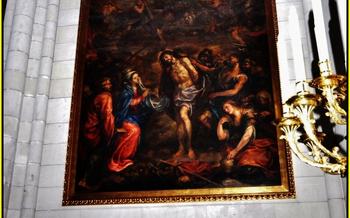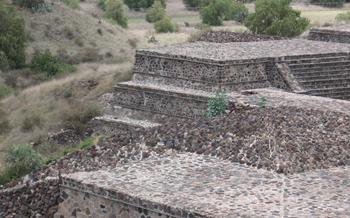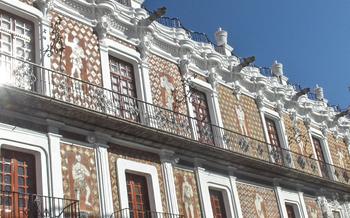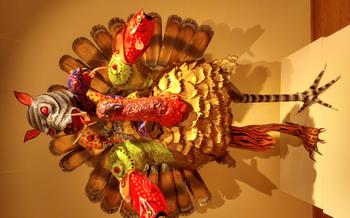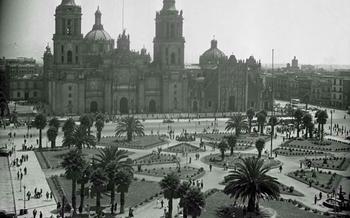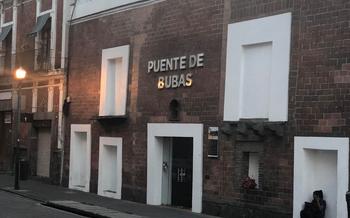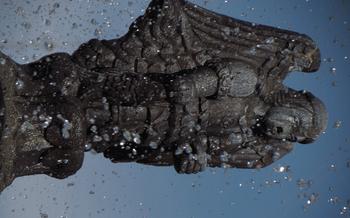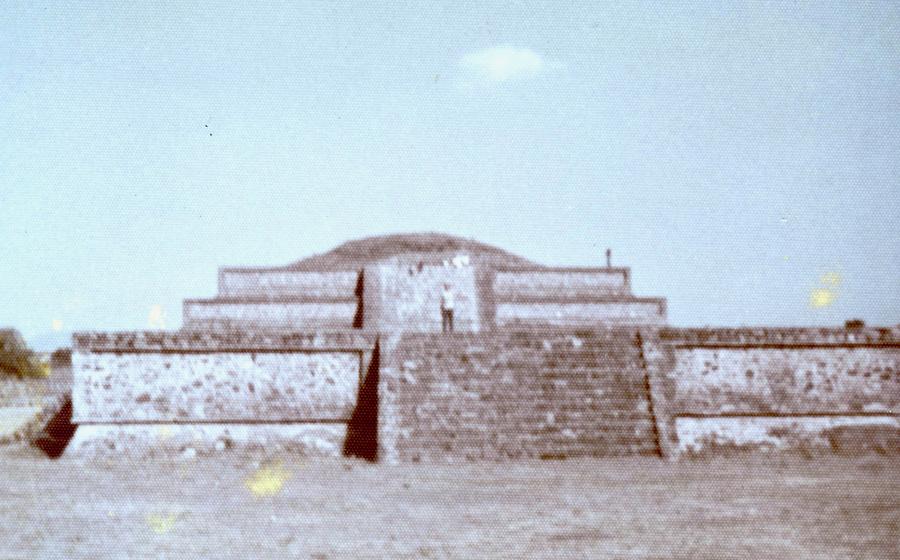
Puebla Cathedral
- Teotihuacan: A City of Mystery and Wonder
- Exploring the Pyramids of Teotihuacan
- The City Layout and Architecture
- The People of Teotihuacan
- Teotihuacan's Cultural Legacy
- Visiting the Puebla Cathedral
- Exploring the Historic Center of Puebla
- Discovering the Talavera Tiles of Puebla
- Savoring the Flavors of Poblano Cuisine
- Convent of Santa Rosa
- Enjoying the Vibrant Nightlife of Puebla
- Shopping for Local Crafts and Souvenirs
- Insider Tip: Exploring the Hidden Gems of Puebla
Teotihuacan: A City of Mystery and Wonder
Teotihuacan, a name that evokes images of grandeur and mystery, stands as a testament to the ingenuity and creativity of ancient Mesoamerican civilizations. Located just northeast of Mexico City, this sprawling metropolis once housed a diverse population of over 100,000 people, making it one of the largest cities in the pre-Columbian Americas. Its origins remain shrouded in obscurity, with various theories suggesting its founding around the 1st century BCE.
Teotihuacan's strategic location in the fertile Valley of Mexico, coupled with its access to important trade routes, contributed to its rapid growth and prosperity. The city served as a major religious, political, and economic center, influencing cultures throughout Mesoamerica. Its legacy continues to captivate modern-day visitors, who flock to marvel at its awe-inspiring pyramids, intricate murals, and enigmatic artifacts.
The best time to visit Teotihuacan is during the shoulder seasons (April-May and September-October) when the weather is pleasant, and the crowds are smaller. However, the city offers a unique experience all year round, with vibrant festivals and cultural events taking place throughout the calendar.
Teotihuacan's cultural significance extends far beyond its impressive physical structures. The city's unique blend of religious beliefs, artistic expression, and urban planning has left an enduring mark on Mexican culture and identity. Its legacy continues to inspire contemporary artists, architects, and scholars, who seek to unlock the secrets of this ancient metropolis.
Exploring the Pyramids of Teotihuacan
At the heart of Teotihuacan lie its awe-inspiring pyramids, towering testaments to the city's architectural prowess. The Pyramid of the Sun, the largest structure in the city, stands as a symbol of Teotihuacan's power and grandeur. Ascend its steep steps to the summit and be rewarded with breathtaking panoramic views that stretch across the entire archaeological site.
Just a short distance away, the Pyramid of the Moon offers a more intimate experience. While smaller in size, it boasts an equally impressive design and intricate carvings that provide glimpses into the city's rich mythology. Stroll along the grand Avenue of the Dead, the main artery of Teotihuacan, and admire the rows of smaller pyramids and temples that flank its sides.
Among these structures, the Temple of Quetzalcoatl, dedicated to the feathered serpent god, stands out with its vibrant murals and intricate sculptures. Take your time to explore each of these architectural wonders, marveling at the precision and artistry that went into their construction. The pyramids of Teotihuacan are not merely impressive structures but also profound expressions of the city's spiritual beliefs and engineering prowess.
The City Layout and Architecture
Teotihuacan's urban planning was highly organized and symmetrical, showcasing a sophisticated understanding of geometry and astronomy. The city was laid out along a central axis, the Avenue of the Dead, which connected the major ceremonial and administrative structures. This grand avenue was flanked by residential and administrative compounds, arranged in a grid-like pattern.
The buildings in Teotihuacan were constructed using a combination of mud bricks and stone, with adobe being the primary material. The city's architects employed advanced building techniques, including the use of vaults, arches, and corbelled roofs. These techniques allowed them to create impressive structures with large, open spaces and high ceilings.
The architecture of Teotihuacan is also notable for its rich symbolism and iconography. Buildings were often decorated with intricate carvings and paintings depicting gods, mythical creatures, and scenes from daily life. These artistic representations provided insights into the religious beliefs and cultural practices of the Teotihuacan people.
The residential areas of Teotihuacan consisted of compounds, each comprising several rooms arranged around a central courtyard. These compounds were likely occupied by extended families or social groups and provided living spaces, storage areas, and workshops. The administrative areas, located near the ceremonial center, included palaces, government buildings, and temples. These structures were larger and more elaborately decorated, reflecting their importance in the city's governance and religious life.
The People of Teotihuacan
The population of Teotihuacan was diverse, with people from various ethnic backgrounds coming together to form a vibrant and cosmopolitan society. The dominant ethnic group was the Nahuatl-speaking peoples, who migrated from the north and brought their language, customs, and traditions to the city. Over time, other groups, such as the Zapotec, Mixtec, and Otomi, also settled in Teotihuacan, contributing to the city's cultural diversity.
Teotihuacan society was highly stratified, with a clear hierarchy and division of labor. At the apex of the social structure was the ruling elite, composed of priests, nobles, and military leaders. They held political and religious authority and controlled the city's resources. The majority of the population consisted of commoners, who worked as farmers, artisans, merchants, and laborers. They were responsible for producing the food, goods, and services that sustained the city.
Daily life in Teotihuacan revolved around agriculture, trade, and religious rituals. The city's economy was largely based on agriculture, with maize, beans, and squash being the main crops. Teotihuacan also engaged in extensive trade with other Mesoamerican regions, exchanging goods such as obsidian, pottery, and textiles. The city's central market was a bustling hub of activity, where traders from near and far gathered to buy and sell their wares.
Religion played a central role in Teotihuacan society. The city was home to numerous temples and shrines, where priests performed rituals and ceremonies to honor the gods and goddesses. The most important deity was Quetzalcoatl, the feathered serpent god, who was associated with creation, fertility, and wind. Other important gods included Tlaloc, the rain god, and Huitzilopochtli, the sun god.
Teotihuacan's Cultural Legacy
Teotihuacan's influence extended far beyond its physical borders, leaving an indelible mark on the cultural and historical development of Mesoamerica. Its architectural innovations, artistic achievements, and religious beliefs were adopted and adapted by subsequent civilizations, contributing to the rich tapestry of Mesoamerican culture. Teotihuacan's trade networks facilitated the exchange of goods, ideas, and technologies, fostering cultural exchange and intercultural dialogue. The city's decline and abandonment around the 7th century AD remain a subject of debate and speculation, but its legacy continues to inspire and intrigue scholars and visitors alike, serving as a testament to the enduring power of ancient civilizations.
Visiting the Puebla Cathedral
A visit to Puebla is not complete without exploring the magnificent Puebla Cathedral, a stunning masterpiece of colonial architecture and a testament to the city's rich history. Located in the heart of the historic center, the cathedral stands as a symbol of Puebla's religious and cultural heritage. Easily accessible on foot from the city's main square, the Zócalo, the cathedral is a must-see attraction for any traveler.
Founded in the 16th century, the cathedral's construction spanned over two centuries, blending various architectural styles, including Gothic, Renaissance, and Baroque. Its imposing façade, adorned with intricate carvings and sculptures, hints at the grandeur that awaits inside. The interior of the cathedral is equally impressive, featuring soaring vaulted ceilings, elegant stained-glass windows, and a wealth of religious artwork.
The cathedral is home to several notable features, including the impressive main altar, crafted from gold-plated wood and adorned with intricate carvings. The choir stalls, with their finely carved seats and intricate wooden carvings, are another highlight, showcasing the exceptional craftsmanship of the era. Visitors can also admire the impressive collection of religious paintings and sculptures, which depict scenes from the Bible and the lives of saints.
Beyond its religious significance, the Puebla Cathedral holds immense historical value. It served as a refuge for the city's inhabitants during various conflicts and epidemics, and its walls bear witness to Puebla's rich past. With its architectural splendor, historical importance, and spiritual significance, the Puebla Cathedral remains a beloved landmark and a source of pride for the city's residents.
Exploring the Historic Center of Puebla
Puebla's historic center, designated as a UNESCO World Heritage Site, is a captivating blend of colonial architecture, vibrant culture, and culinary delights. Stroll along the cobblestone streets lined with beautifully preserved buildings showcasing a fusion of Spanish, Moorish, and indigenous influences. Admire the intricate facades, ornate balconies, and colorful tiles that adorn the city's landmarks.
The Zócalo, the city's main square, is the heart of Puebla's history and culture. Here, you can witness the grandeur of the Puebla Cathedral and the Municipal Palace, marvel at the intricate Talavera tiles covering the Portal de las Flores, and soak in the lively atmosphere as locals and visitors gather to enjoy the city's vibrant energy.
Don't miss the opportunity to explore Puebla's numerous museums, galleries, and theaters. The Amparo Museum houses an impressive collection of pre-Columbian artifacts, colonial art, and modern masterpieces, while the Museo de la Revolución Mexicana offers a glimpse into the country's revolutionary past. For a taste of Puebla's vibrant arts scene, catch a performance at the Teatro Principal or the Teatro del Estado, where renowned Mexican and international artists showcase their talents.
Puebla's historic center is a foodie's paradise, offering a delectable array of traditional and contemporary cuisine. From street stalls serving mouthwatering tacos and cemitas to renowned restaurants showcasing modern Mexican gastronomy, Puebla's culinary scene is sure to tantalize your taste buds. Don't miss the chance to savor the city's signature dish, Mole Poblano, a complex and flavorful sauce served with chicken or turkey, a testament to Puebla's rich culinary heritage.
Discovering the Talavera Tiles of Puebla
Puebla is renowned for its exquisite Talavera tiles, a unique form of glazed ceramic tile with a rich history and cultural significance. The art of Talavera tile making originated in Spain during the 15th century and was brought to Mexico by the Spanish conquistadors. In Puebla, this art form flourished, and the city became a renowned center for Talavera production.
The unique characteristics of Talavera tiles lie in their intricate designs, vibrant colors, and meticulous craftsmanship. Each tile is hand-painted with a variety of patterns, often depicting scenes from Mexican history, mythology, or nature. The colors used are typically bright and bold, creating a striking visual effect.
To create a Talavera tile, artisans begin by shaping the clay into a flat square or round form. Once dried, the tiles are coated with a white glaze and then hand-painted using natural pigments. The tiles are then fired in a kiln at a high temperature, which fuses the glaze and paint together, creating a durable and long-lasting finish.
Notable examples of Talavera tiles can be found throughout Puebla, adorning the facades of historic buildings, churches, and public spaces. One of the most famous examples is the Talavera tile mural on the exterior of the Capilla del Rosario in the Santo Domingo Church. This stunning mural depicts scenes from the life of Saint Dominic and is considered a masterpiece of Talavera art.
Visitors to Puebla can shop for Talavera souvenirs in the city's many artesanía shops and markets. These shops offer a wide variety of tiles, from traditional designs to contemporary interpretations. Talavera tiles make unique and beautiful souvenirs, adding a touch of Mexican charm to any home or collection.
Savoring the Flavors of Poblano Cuisine
Puebla's culinary scene is a vibrant tapestry of traditional flavors and innovative creations, reflecting the city's rich cultural heritage. Mole Poblano, the city's signature dish, is a complex and flavorful sauce made with a blend of chiles, spices, nuts, seeds, and chocolate, served over chicken or turkey. Other notable dishes include Chiles en Nogada, a dish of poblano chiles stuffed with picadillo and topped with a walnut sauce and pomegranate seeds, and Cemitas, a type of sandwich made with sesame-seed-crusted rolls, filled with various meats, vegetables, and condiments.
For those seeking a more immersive culinary experience, cooking classes are available, offering hands-on instruction in preparing traditional Poblano dishes. Visitors can also explore the city's vibrant street food scene, where vendors offer a variety of local delicacies, from tacos and tortas to fresh fruit and traditional sweets. Puebla's markets are also a great place to sample local flavors and find unique ingredients, such as the city's renowned Talavera pottery, which is used to create colorful and intricate serving dishes and cookware.
Convent of Santa Rosa
Amidst the enchanting streets of Puebla, the Convent of Santa Rosa stands as a testament to the city's rich colonial heritage and architectural prowess. Founded in 1697 by the Dominican order, this sacred sanctuary was conceived as a refuge for the daughters of prominent families who sought a life of devotion and seclusion.
The convent's architectural design exudes an aura of serenity and elegance, blending Baroque and Churrigueresque elements with a distinctly Mexican flair. Its imposing façade boasts intricate carvings, delicate moldings, and a grand portal that invites visitors into a world of spiritual contemplation.
Stepping inside the convent, one is greeted by a breathtaking display of Talavera tiles, adorning the walls, floors, and even the majestic dome. These vibrant tiles, a hallmark of Puebla's artistic tradition, depict scenes from biblical narratives, nature, and everyday life, creating a kaleidoscope of colors and patterns that captivate the eye.
The convent's interior is a treasure trove of artistic wonders. The main chapel, with its soaring ceilings and ornate altarpieces, is a masterpiece of Baroque architecture. Every nook and cranny of the convent reveals hidden gems, from intricately carved choir stalls to exquisitely painted murals that narrate the lives of saints and martyrs.
Beyond its aesthetic beauty, the Convent of Santa Rosa holds immense historical and cultural significance. It served as a sanctuary for women during times of war and social upheaval, providing refuge, education, and spiritual guidance. The convent also played a crucial role in the city's cultural development, nurturing the arts, music, and literature.
Today, the Convent of Santa Rosa has been lovingly restored and transformed into a museum, inviting visitors to delve into its rich history and artistic legacy. Through guided tours, one can explore the convent's cloisters, chapels, and living quarters, gaining insights into the lives of the nuns who once called this sacred space home.
Whether you are a history buff, an art enthusiast, or simply someone seeking a moment of tranquility, the Convent of Santa Rosa offers an unforgettable experience that will leave you spellbound.
Enjoying the Vibrant Nightlife of Puebla
Puebla comes alive at night, offering a diverse range of entertainment options for visitors. The city's vibrant nightlife scene is centered around several popular entertainment districts, each with its own unique character.
One of the most popular areas is the Zona Angelópolis, a modern district known for its upscale bars, nightclubs, and restaurants. Here, you can find everything from trendy rooftop lounges to lively dance clubs, as well as a variety of international cuisine options.
For a more traditional experience, head to the historic center of Puebla, where you can enjoy live music, traditional dance performances, and cultural festivals in the city's many plazas and courtyards. The narrow cobblestone streets are lined with charming bars and cafés, offering a lively atmosphere and a chance to mingle with locals.
Throughout the year, Puebla hosts a variety of cultural events and festivals that showcase the city's rich heritage and traditions. These events often feature live music, dance performances, traditional food, and artisanal crafts, providing a unique opportunity to experience the vibrant culture of Puebla.
No matter what your preference, Puebla's nightlife has something to offer everyone. Whether you're looking to dance the night away, enjoy a live music performance, or simply soak up the city's vibrant atmosphere, you'll find plenty to keep you entertained after dark in Puebla.
Shopping for Local Crafts and Souvenirs
When visiting Puebla, immersing yourself in the vibrant shopping scene is a must. The city offers a plethora of traditional markets and artesanía shops where you can find a treasure trove of unique crafts and souvenirs.
Stroll through the bustling El Parián market, a renowned shopping destination for Talavera pottery and ceramics. Here, you can marvel at the intricate designs and vibrant colors of these exquisite handmade pieces. From plates and bowls to decorative tiles and figurines, there's something for every taste and budget.
Venture into the narrow streets of the historic center to discover hidden gems like the Calle de los Dulces, where you can indulge in traditional Mexican candies and sweets. Don't miss the chance to sample the famous "camotes," a sweet potato-based confection that is a local favorite.
For handcrafted textiles and embroideries, head to the Mercado de Artesanías. Here, you'll find an array of colorful blouses, skirts, and dresses, as well as intricate bordados (embroideries) that showcase the skill and artistry of local artisans.
When it comes to unique souvenirs, consider purchasing a hand-painted Talavera tile, a miniature alebrije (a fantastical creature), or a traditional Mexican mask. These colorful and expressive pieces make for wonderful mementos of your travels in Puebla.
Remember to haggle politely when shopping at local markets, as it's a customary part of the shopping experience in Mexico. By doing so, you'll not only get a good deal but also contribute to supporting the local economy and the talented artisans who create these beautiful handmade goods.
Insider Tip: Exploring the Hidden Gems of Puebla
Venture beyond the main tourist trails to discover the hidden gems of Puebla. Explore the charming neighborhood of Barrio del Artista, where local artisans showcase their craft in colorful workshops and galleries. Immerse yourself in the vibrant flavors of Poblano cuisine at Mercado La Acocota, a bustling market offering traditional dishes and exotic ingredients. For a unique cultural experience, attend one of the many festivals and events that take place throughout the year, such as the Festival Internacional 5 de Mayo or the Feria de Puebla.
Engage with the friendly locals to learn about their traditions and customs. Visit the Casa de la Cultura to attend workshops, exhibitions, and performances that celebrate Puebla's rich cultural heritage. Don't miss the opportunity to indulge in a traditional temazcal (sweat lodge) experience, a purifying ritual that has been practiced by indigenous communities for centuries.
